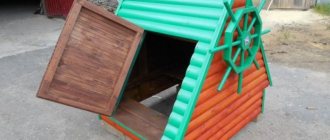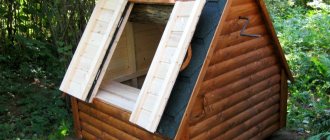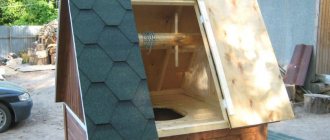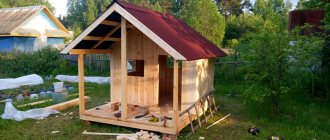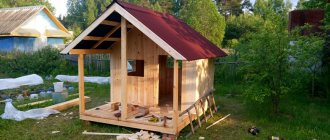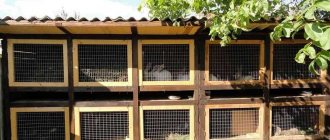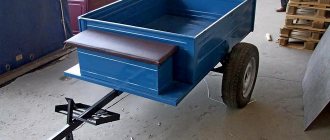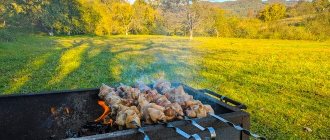Original ideas for building and decorating a well house can be made with your own hands using standard construction tools. The creation of a private well traditionally ends with the arrangement of a house, which is both a protective and decorative element. There are quite a lot of options for the finishing design of the mentioned structure, but the order of arranging the houses as a whole remains almost the same. Only the dimensions, configuration and design features change. Traditionally, wood is used to create houses. Read the provisions of the presented guidelines and choose the house design option that suits your case.
DIY well house
Why do you need a well house?
A large selection of ready-made well houses is available for sale. However, the cost of this type of product leaves much to be desired. Therefore, many owners decide to build well houses on their own - there is nothing complicated about it.
Well house
The main purpose of the well house is to protect water from various types of pollution and direct sunlight. Insects, garbage, animals, excess heat - all this negatively affects the quality of water.
The house will also provide reliable protection of the well from various types of precipitation and chemicals used to spray vegetation. In winter, a properly equipped house will not allow the water in the well to freeze.
Well house
Gate installation
Another detail that you can’t do without if you get water with a bucket is a well gate, designed for winding a chain when the water rises. The material used for it is usually a thick log, often oak, since oak wood is one of the most durable. We make the length of the gate 4 cm shorter than the distance between the posts, and sand its surface. Then we make a wire wrap at the ends of the gate and drill holes 5 cm deep and Ø 2 cm strictly in the center of the log. Based on preliminary markings, we drill two holes in the pillars and install a gate adjusted to the length above the well using cap screws Ø 10 mm (photo 6).
Set for work
- Woodworking Machine. This device will allow you to process wooden blanks as quickly and efficiently as possible. If you don't have access to a woodworking machine, at least have an electric plane ready.
- Circular Saw.
- Electric jigsaw.
- Hacksaw.
- Nail puller.
- Phillips screwdriver.
- Hammer.
- Pencil.
- Building level.
- Roulette.
- Edged board.
- Beam.
- Fastening elements.
- Roofing material. Choose at your own discretion. The main thing is that the support can properly withstand the weight of the finish, and that the roof itself is in harmony with the surrounding space. For example, slate, roofing felt, and metal tiles are suitable.
- Door.
- Door latch.
- Pen.
- Loops.
Prices for popular models of jigsaws
Jigsaw
Design options
Once the base of the structure is made, it can be designed in various ways. As a result of the correct choice of the way in which this should be done, the well will acquire not only practical significance, but also aesthetic and design value.
Roof finishing
The roof can not only be made from neat, beautiful boards, but also decorated with carved wooden parts.
Unusual options for this part of the structure may also be used. One of these options involves a folding design made of thick glass. It is structurally made in the form of a cover over the well, which opens on door hinges mounted on the well frame.
You can provide a semicircular metal roof, decorated with curlicues made of metal.
Decorative finishing of a well with forged elements Source dozor.spb.ru
It is possible to design this part of the well in the form of a hexagonal pointed structure.
Sometimes when choosing what to cover a well with, a soft roof can be a good choice.
Concrete ring frame
Using a stone around the concrete ring, create a beautiful stone wall that completely hides it. This can be done in various ways. For example, an imitation of a small door made of wood in a stone fence may look beautiful.
It is possible to use logs in the form of a log house in a folk style. Sometimes such a frame is made not quadrangular, but hexagonal.
An option can also be used when, using wooden planks coated with varnish, a design is made that resembles a wicker basket. To do this, they are laid out horizontally at each level so that they look like a polygon. In this case, at each next level above the corner there is a flat part of the board.
Decorative finishing - a well in the form of a basket Source stroim-dom.radiomoon.ru
Using an unusual gate shape
This part can be made, for example, in the form of a steering wheel of a sailing ship, or simply in the form of a wheel with spokes installed perpendicular to each other.
House with a gable roof
House for a well with a gable roof
The simplest and most popular design option. Such a well house can be easily built from available equipment, because... almost everything necessary (timber, boards, fasteners) remains after the completion of larger construction activities.
House for a well with a gable roof
Frame
To create the base of such a house, boards and wooden beams are used.
Well houses
Expert opinion: Masalsky A.V.
Editor of the “construction” category on the Stroyday.ru portal. Specialist in engineering systems and drainage.
First of all, it is necessary to select the optimal dimensions of the main structural elements. If the parts are too thin, the well house may not withstand wind and other loads. Elements that are too voluminous will make the house bulky.
House diagram. 1 – base frame, 2 – gables, 3 – pillar, 4 – roof ridge, 5 – gate, 6 – gable cladding, 7, 8 – roof slopes
Well house with door
Well house with door
Therefore, stick to the recommended and time-tested parameters. Thus, the optimal thickness of the board is 4 cm, the cross-section of the timber is 8x10 or 10x10 cm. The design of such a house consists of four posts made of timber and the same number of boards, suitable for making the upper and lower trim. The recommended width of the boards is 120-150 mm.
Well house frame
Saw off the boards in advance in accordance with the dimensions of your well, and then nail all the elements one by one to the support posts. As a result, you will get a reliable and even frame. To fasten elements of the mentioned dimensions, use nails approximately 100 mm long.
Gate device
At this stage, it is best to adhere to the following algorithm:
- fasten the first pair of support posts, bottom and top, with boards;
- connect the remaining pair of support posts in the same way;
- install prepared structures around the well;
- finally connect the frame elements with straps.
Installing a house on the top ring of a well
House installation
Well house
Roof and upholstery
Start arranging the roof of the well house. Start by installing trusses - this is a rigid structure designed to attach the sheathing. Make trusses from durable boards with a thickness of at least 30 mm. Select the length individually - the final height of the well house directly depends on this indicator.
Well house
House frame
Prepare boards for jibs and crossbars. Material 2.5-3 cm thick will be enough. In general, you need to prepare 6 rafter legs, 3 crossbars and 8 jibs. Cut the rafters at an angle, and then connect the upper ends of the products to each other. Fasten with self-tapping screws.
To prevent debris from getting into the well or any animals or insects from getting into the well, you need to cover the house with plastic wrap
To prevent debris from getting into the well or any animals or insects from getting into the well, you need to cover the house with plastic wrap
For additional fixation of the rafters, use crossbars. They should be placed 30 cm below the point of the upper rafter fastening. Create cutouts at the junctions of the rafter elements with the top trim boards. Use 12 cm nails to connect the rafters and frame.
Roof of the house
Strengthen the fixation of the rafter elements with jibs. To connect the trusses, use a kind of ridge - a structure made of two boards. Attach the sheathing boards in increments of about 15 cm. Provide 10 cm protrusions above the walls of the building. Cover the finished roof frame with roofing felt, and on top of it, if desired, attach the finishing roofing material at your discretion. Finally, all you have to do is cover the corner joints with wind boards.
Well house
Well house
It is most convenient to assemble the roof structure frame on the ground.
House roof cladding
Door
The door of such a well house looks like a kind of plank shield. The door is made according to an extremely simple principle. Cut boards about 150-200 mm wide. The length will be enough 85 mm.
House door
Place the boards one next to the other and fasten them with 30x25 mm bars. Two bars will be quite enough - you fix one on top, and nail the second from below. To fasten the elements of the product, use self-tapping screws. Four screws for each board will be enough.
Nail an additional diagonal block. It will help increase the rigidity of the product. Frame the gables, attach the latch and handle, and then hang the finished door on its hinges.
What should a high-quality antiseptic be like?
Don’t forget to treat the outside of the product with an antiseptic and varnish it. Before applying varnish, you can paint the door with waterproof paint.
Parts for manual gate
Gate
Gate
Gate
Option for covering a house with corrugated sheets
Prices for various types of lumber
Lumber
Step-by-step instruction
Making a high-quality house structure requires a careful approach. To do this you need:
- make a drawing of the house for the well with exact dimensions;
- choose the right material that will fully meet the desired characteristics;
- select a working tool according to the selected materials;
- carry out preparatory work, manufacture all the parts and assemble them into a single structure.
Perform antifungal and anti-corrosion treatment.
Log house
Such a well house will have an original and very interesting design. To build such a structure you will need the following:
Log house
- rounded logs;
- boards for roofing and supports;
- finishing coating for roofing;
- material for arranging a gate with a comfortable handle.
Similar well houses are often found in villages. The pillars of the structure, gates and the log house itself are made from rounded timber.
Log house
Manufacturing technology
Fold the rounded timber into the log house according to the dimensions of the well. Connect the timber using any suitable and convenient method. Install two massive wooden beam supports. For additional rigidity, equip the house posts with supports. Place a wide roof structure on top of the support posts. The instructions for constructing the roof were given in the previous section of the instructions - do everything in the same order.
Well house made of logs
The edges of the roof should extend beyond the base of the well house. This will prevent precipitation from entering the well shaft.
Fasten the gate securely. You can decorate the protruding ends of the beam with a variety of curly cutouts.
Advice from experts on arrangement
The choice of a place to dig a well in a country house or a private country plot is made in compliance with a number of rules.
It is erected according to certain rules, and here are the main ones:
- The water source cannot be located closer than 8 meters from the outdoor toilet.
- If the sewage system at the dacha is designed as an absorbent cesspool (septic tank without a bottom), and the well is intended for drinking water, then the well shaft should be located at least 50 m from it.
- In the case of a sealed cesspool or if the water will be used exclusively for watering the garden, this distance can be reduced to 20 m.
- Also, the water source should not be located close to silos. The distance to them should also be at least 8 m.
Here it is worth considering that the greater the distance of your well shaft from all kinds of structures that pollute groundwater, the better.
This diagram shows that the well from the septic tank must be located at a distance of at least 20 m if the water is intended for household needs, and 50 meters if the water is intended for drinking
Tip No. 1 - time to carry out work
It is best to start work when the aquifer is at its lowest level. And it decreases significantly either during periods of prolonged drought, or after a month has passed after the first frosts hit.
Why during these periods? During these periods, water horizons are not recharged with water - in summer due to insignificant precipitation, and in late autumn and winter because the freezing upper layer does not allow water to penetrate into the earth.
Even though it’s freezing outside, you can go as deep into the aquifer as possible and comfortably. At this time, its recharge is minimal
You can dig a well at normal times, but in this case, at the last stage, you may not be able to penetrate well enough into the aquifer.
If you plan to make a filter, which is at least 60 cm, and have at least one ring of water in the well - 80 cm, then you will have to go deeper below the upper threshold of groundwater by about one and a half meters. And the easiest way to do this is in conditions where water does not remain constantly and at high speed.
But, if you rely entirely on a good pump that can pull slurry mixed with sand, then this is not a problem. In both cases, you will have to tinker in the slurry. And, of course, it is better if it is in warm weather.
Tip #2 - searching for groundwater
Many could see how some specialists, in search of water, walk around an area with two frames. Where they intersect, then, supposedly, the aquifer passes close to the surface.
To this we would like to note that any real hydrogeologist will tell you that:
- Water is everywhere and always, except, of course, when you live on the side of a mountain. If the terrain is more or less flat, then the groundwater belt lies, as a rule, at the same distance from the surface of the earth. If your site is hilly, in this case, it would be more acceptable to consider digging a mine in a low area. You can save money on 1-2, or even 3 rings, depending on what elevation changes your country landscape has.
- Searches using frameworks yield absolutely nothing. The effectiveness of this method has not been proven by scientists. Therefore, if you hire a home-grown specialist who practices this method, be aware that this specialist is most likely hanging noodles on your ears. Another thing is that you cannot prove this. As already mentioned, water is everywhere. And the fact that he made a mistake a couple of rings down or up, he will write off as the costs of the method, which he will warn you about in advance.
- The best way to find out at what distance the water lies is to either ask a neighbor on whose property there is already a well, or ask local geologists, drillers and meteorologists. They have engineering-geological maps, from which they will determine the depth of groundwater.
Well, when we have decided on a place, we go to get the rings and the necessary tools and equipment, if there is none at your summer cottage.
Some craftsmen search for water using such frames. But there is no scientific confirmation of their effectiveness, so it is better to entrust this operation to specialists
Tip #3 - choosing rings
It all depends on the diameter of your shaft. If you want to have a wide well, you can take wider rings. Of course, it takes longer to dig, but it is more convenient both to dig and to use. You can turn around properly, use a shovel with a longer handle, etc.
If you are satisfied with a narrow design, you can opt for rings of small diameter. In order to “get a feel for the situation,” you can climb into one of the rings right at the company and try to turn around in it. Whichever one will be more convenient to work in, take those.
The best option for a country well would be KS 10.9 tongue-and-groove, manufactured in accordance with GOST 8020-90. Of these, installing a shaft is a pleasure.
There are rings with a deeper lock, but they still have to be fastened together with staples to prevent shifts due to heaving
Tip #4 - what to do with quicksand?
Quicksand is a layer of silty clayey sand saturated with water. It resembles a dirty slurry in appearance; it is very difficult to obtain water from it: it is only possible as a result of long-term settling. And even then there will be too little of it, so extracting water from quicksand is pointless.
In general, the presence of quicksand in a section is an extremely rare geological situation. They are found only in glacial deposits, which are found, for example, in the Leningrad region. However, if you get caught, it would be advisable to go deeper below this layer. Only in this case will it be possible to ensure constant and rapid filling of the mine with water.
The process of overcoming quicksand is very labor-intensive. The legs are constantly being sucked in, and the accumulating water and slurry create additional difficulties in work. But if you want the well to be full, you will have to do this.
Three staples on different sides are enough to ensure that the rings are held tightly together. Quicksands of this design are not scary
Tip #5 - don’t delay the work
It is advisable to carry out work on arranging a well in the country as soon as possible. Delaying the work using the open method will lead to the collapse of the pit walls.
And if in a situation with the open method, the situation can be corrected by cleaning the hole and covering the crumbled edges with earth after installing the rings in the shaft, then in the second case it may be necessary to use a crane.
Upon completion of digging the well and backfilling the bottom filter, it is advisable to pump out the first water from it. Then it is mandatory to take a water sample for analysis in order to submit it for laboratory testing. Only after this will it be possible to decide whether it can be used for technical or drinking purposes.
Hexagonal well house
Hexagonal well house
Modification of the previous design. The only difference is the shape - it is hexagonal and allows you to save additional space, which is important for owners of compact wells and small plots of land.
Hexagonal well house
In general, the sequence of construction of this house remains the same as in the case of the construction of an ordinary quadrangular building made of timber. The house is well suited for framing a shaft with pumping equipment.
Types of well pumps
For construction, it is recommended to use a 10-centimeter beam. You can trim the roof with edged boards - it looks very beautiful and original. Be sure to treat all wooden structural elements with antiseptic impregnation.
Prices for popular types of antiseptics
Antiseptics
Designs, diagrams and drawings
First, let's decide how many walls our house will have. You can choose a rectangular or hexagonal frame.
The tetrahedral version looks more traditional, but the hexagonal version also has its advantages. The design of such a log house will allow you to save space; it takes up less space and is well suited for small areas. Otherwise, it’s more a matter of taste; each option can be played up, decorated, decorated in its own way.
There are more simplified open-plan designs without walls. They perform their function just as well, but are easier to manufacture. There are also closed and open designs. The closed structure differs in that it completely hides the well, while the open one consists of walls along the height of a concrete ring and a roof.
Decorating the house
Carved well house - decoration of the site
Several methods can be used to decorate the house. A popular decoration option is carving. A neat carved house will fit into any landscape, the design of which is made using wood.
Decorating the house
Another simple and popular option for decorating such structures is painting. Varnishes and impregnations allow you to radically change the texture and color of the material.
In some situations, it will be appropriate to decorate a house using a ceramic or wooden figurine of an animal.
Well houses
Otherwise, each owner must independently think through the finishing design of the well house so that the finished structure fits well into the environment and fully demonstrates the individuality and taste of the owner.
Good luck!
Video - DIY well house
Variations of the structure
The protective structure can be open or closed. In the first case, the likelihood of water freezing in severe frosts increases significantly. Insulating the well ring with an expanded polystyrene foam coat followed by decorative finishing will help save the situation. A closed type design is more practical from the point of view of frost protection. The air layer itself retains heat, and in combination with thermal insulation material it copes perfectly with the functions assigned to it.
The choice of materials when making a house for a well is based on the general architectural concept of the suburban area. If the main structure is a wooden frame, it would be logical to use logs to finish the well ring and boards for the roof. If the exterior of the house contains elements of brick or stone, the corresponding material is used when assembling the structure for the well with your own hands. The top is sheathed with material identical to the roofing of the main building. The proposed design is not an unshakable postulate and is relevant if the house is located within sight of the main building. A well located further away allows you to expand the boundaries of the choice of finishing for the house.
Comment! A wooden house, especially with carving elements, is incredibly attractive, but requires regular maintenance. Otherwise, the appearance will quickly lose its former luster. Siding mounted on a metal profile frame is much easier to maintain.
Another example of a drawing with dimensions will help you navigate the choice of configuration:
How they did it in the old days
You cannot simply secure the constructed gable roof to the side posts with a collar. It is necessary to thoroughly strengthen and strengthen the supports, install struts, and only after that attach the protective canopy. Otherwise, at the first strong wind, due to the large windage, the roof can simply destroy the pillars and even throw off the gate. An illustration of how seriously in the old days they approached the problem of installing a roof for a well with their own hands can be seen in the diagram of a log house below.
An ordinary wooden chopped well was always equipped with a fairly high and wide roof with a roof span of more than 2.5 m. The height of the ridge above the ground was also about 2.5 m. The result was a rather bulky structure, capable of accommodating at least five people under a canopy. The height of the overhangs was about 2 m, this is enough to use the well even in winter, with a lot of snow.
In order to reliably fix and hold a fairly heavy hinged structure, the craftsmen had to use the following solution:
- Install two vertical log posts with a diameter of 200 mm. They also served as supports for installing the lift gate;
- The supports, about four meters long, were dug 1/3 into the soil backfill without concreting or installing external struts;
- The roof support posts were not connected to the frame, so any lateral or vertical load on the roof did not in any way affect the stability and strength of the well head.
Almost the entire well structure, from the roof to the lower crowns of the frame, was made of oak. The lower parts of the supports driven into the ground were first burned to charcoal, covered with birch tar and coated with clay. As a result, the roof and the well itself served for many decades, delighting the owners with clean water and a convenient device.
Kinds
- Open.
- Closed.
An open one can have a simple visor made of metal or wood.
The canopy comes with a pitched or gable roof on two pillars. The drum is fixed on the supports. Additionally, there may be a cover on the ring itself. As for the closed ones, these are full-fledged houses that completely block the source. A door is made in the roof.
Pros of open houses:
- Easy to manufacture. It is enough to secure the knob and trim it, as well as install a small canopy or cover.
- Low cost.
- Minimum consumption of building material.
Disadvantages of open structures:
- If there is severe frost in your area, the water may freeze.
Important: when the house is open, it is necessary to insulate it from polystyrene foam shell.
Advantages of closed well houses:
- excellent thermal insulation;
- The rings completely overlap.
Disadvantages of a closed structure:
- the top of the well will cost more;
- it will require more labor and time.
Advice: some people buy ready-made solutions. However, they are not always of the best quality. Therefore, it is more profitable to do it yourself.
